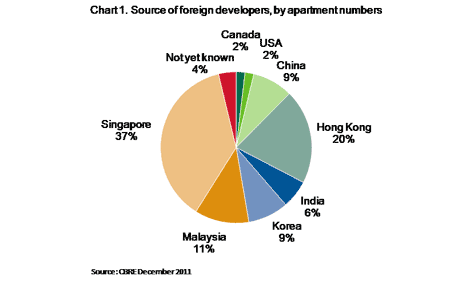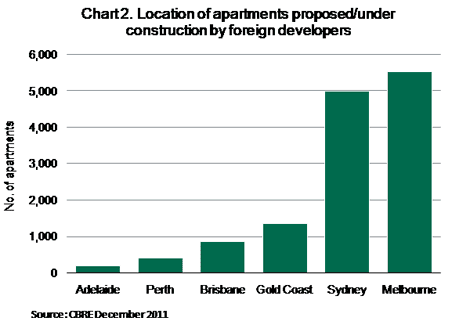Frasers’ Central Park boosts offshore apartment projects to 20-year high: CBRE

Singapore-based developer Frasers’ enormous Central Park residential development on Sydney’s Broadway has helped drive the number of apartment projects being built by offshore developers in Australia to a 20-year high, according to research by CBRE.
Dominated by Asian firms, offshore developers now have almost a third of the new apartment market, with more than 13,000 apartments either planned or in the marketing/construction phase in 37 separate projects across the country.
Based on average apartment completions in Australia in 2011 this represents a market share as high as 32%.
According to CBRE, developers from Singapore are proposing or building more apartments in Australia than developers from any other foreign country at present, and by a big margin.

Singaporean developers are responsible for almost 5,000 apartments presently planned or underway, with 58% by Frasers Property, and 65% of these in the Central Park project in Sydney.
To date, more than 500 apartments have been sold off-the-plan for the first residential stage, One Central Park, which is due for completion by mid-2013 with prices ranging from $460,000 to $1.25 million.
In October, Frasers and Japanese joint venture partner Sekisui House secured $550 million in funding for the 5.8-hectare mixed-use Central Park development.
The next most significant source of development capital is Hong Kong, with a single developer (Far East Consortium) behind 2,700 apartments in two Melbourne projects.
Malaysia (12%), China (9%), Korea (9%) and India (6%) make up the balance of what is a broad spread of Asian sources presently facilitating apartment projects in Australia.
According to CBRE executive director of global research and consulting Kevin Stanley, foreign developers had not been this active in Australia since the building boom of the late 1980s/early 1990s, when mostly Japanese companies were active in developing offices, shopping centres and hotels.
The level of offshore investment in residential apartments mirrors the dramatic increase in the participation of overseas investors in Australian commercial property, which has also reached a two-decade high.
Like commercial property, overseas developers view Australia as a safe and steady market to diversify their activities and grow their businesses and one where there is steady occupier and investor demand for apartments.
Sydney and Melbourne account for four out of five apartments projects (79%) with the Gold Coast (10% of total), Brisbane (6%), Perth (3%) and Adelaide (2%) also popular destinations for offshore developers.

“In a surprising result, Melbourne has a greater number of apartments proposed by foreign developers than Sydney, despite being a city with 450,000 fewer people,” says Stanley.
Earlier this week, Chinese developer acquired a South Yarra residential development site for $18 million.
Stanley says reasons for Melbourne’s appeal include its long-term connection to Asian countries through education and tourism; the greater availability and lower relative price of sites; and the city’s national reputation for the ease of conducting property business.
Melbourne is experiencing the highest concentration of CBD projects of any of the major cities while Sydney has a much more balanced distribution of apartments between the CBD, city fringe and suburban submarkets.
“This is a function of the tightness of site availability and the expense of land in the CBD, along with a growing acceptance of high-density living in suburban nodes, especially near railway stations,” says Stanley.
“In Brisbane, the city fringe has been much more popular with foreign apartment developers than the CBD, although there is a much smaller relative penetration by foreign developers generally into the Brisbane market to date, with a greater focus on nearby Gold Coast instead.”
Stanley says the impacts of foreign involvement in the apartment market were many and were mostly positive.
“Critically, it’s providing a stimulus to the construction sector at a time when development activity is generally at a low level,” Stanley says.
“Second, it’s providing new ideas, standards and designs to broaden the product range in Australia and introduce fresh competition in these areas. Coupled with development by local companies, it’s also leading to the urban renewal of precincts of Australian cities that have previously been underdeveloped and activating these areas with a new range of quality facilities, often in a mixed-use environment. The northern fringe of the Melbourne CBD and the southern area of the Sydney CBD stand out in this regard.”